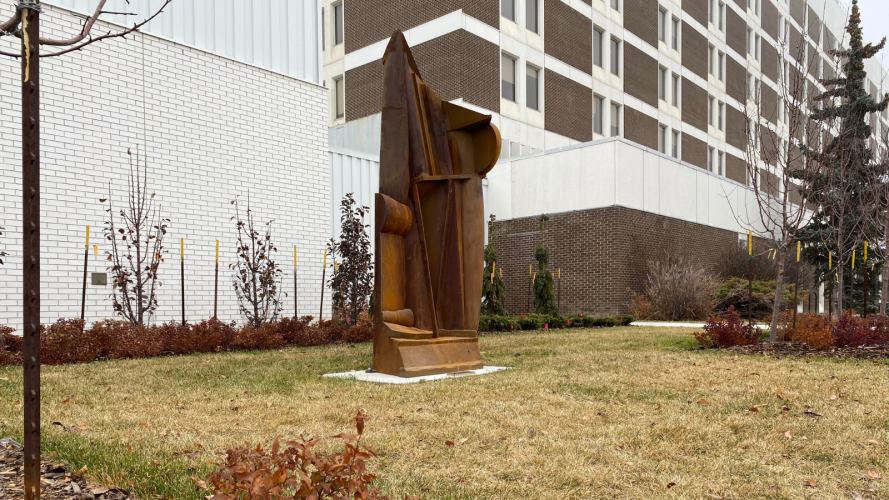On Monday, October 30, the AFA installed Peter Hide's Squashed Freemason sculpture in its new location outside the Misericordia Hospital's revamped emergency department in Edmonton. Artist Peter Hide was on-site to assist with the installation and made some time for the AFA to ask him few questions about the artwork and his career.
The AFA has acquired several of Peter Hide's artworks for its Art Collection, some of which are displayed publicly. View all of Peter Hide's artworks in the AFA Art Collection.
A Q&A with Peter Hide
Q: As an artist you want as many people as possible to engage with your work. How would you describe what it's like to have your artwork available to so many people?
A: You like it because lots of people can see it. Maybe it will stay there for ages and ages. These days things don't always last but the AFA has quite a few of my sculptures all over the place and I'm very grateful for that.
Q: The artwork that was just reinstalled at the Misericordia Hospital was started in 1983. Would you say your artwork has been able to stand the test of time?
A: Yes. That artwork has been in several different places. I think at one point it was in a private collection back in 1986.
Q: How much does the artwork weigh?
A: One ton. Roughly one ton.
Q: Is it difficult for you to part with an artwork after spending so much time working on it?
A: Not really. Do I treat them like children and I don't want to let them go? No, not really. I like it if it goes to someone. So, no I like when they go. I mean, I quite like having them and if they are around I tend to keep working on them, refining them. So, in a way, I'm a bit of a slow worker but I have made quite a few sculptures.
Q: How many would you say you've made?
A: Four or five hundered. My teacher and mentor Anthony Caro was much more famous than I. I think he's made about 8,000. He works in a different way. He works with quite a lot of technicians but he's quite a great sculptor.
Q: Can you describe what it was like the first time one of your sculptures was selected for public display?
A: The first one that was on public display was when I was student at St. Martins in London. It was in an art gallery but it was also a chemist shop I think. It was in Chelsea though and it sold for 33 pounds that was in 1966. It was great. I thought maybe just maybe I might make it.
Q: Are you currently working on anything?
A: I'm working on tons. I have two warehouses and they're both full. You know, art is difficult: it's open to fashion. When I was 25, I was very well known in England and I sold quite a lot of sculptures there but it passed. That's why I came over the pond. Then it all happened all over again.
Q: Your artwork is part of the AFA Art Collection. Can you describe what that means to you as an artist?
A: I'm very pleased about that. They've really looked after the work. I think they've been very good for me.
Q: Do you have any advice for artists when it comes to large scale sculptures?
A: I think people have to find their own way. When I was an art student, I followed Anthony Caro and he made large spreading sculptures, so I tried to make that as a student. My problem was trying to find out how small I could go. Making sculptures as large as a room didn't suit me very well. Caro would stretch things out. He would stretch sculptures and I wanted to compress the sculpture. I was more traditional in a sense, more like I was a wood carver to start. I had a carver's idea about sculpture.
Q: You've been working as an artist for a long time, can you describe one of your favorite moments as an artist living in Alberta?
A: Oh, that's hard. That's a difficult one you know. I think the first public thing I had was in the Edmonton Art Gallery (now the Art Gallery of Alberta) as it was in those days. I had an exhibition there after I had been here for nine months. That was very pleasing and I thought that I might want to stay here. Everything was new. In New York and London things had moved on and in Edmonton it was fresh. There were many good artists and there was quite a range of people creating. Painting and making sculptures.
Q: You did a bit of maintanence on Squashed Freemason before the re-installation, what was it like to work on it again?
A: It was quite interesting. It's changed. It's been outside for many years and I liked that it got more and more rust on it and it looked like a big monument that was made out of stone or granite. It feels like a monolith.
Q: The artwork has been installed at the Misericordia for a number of years. Now it has been moved in front of the new emergency room. So, something old will be part of something new. What are your thoughts on this?
A: It will get a lot of traffic where it is now. Before it was a bit tucked away. A lot of people will get to see it and I like the idea of that.
Q: What was it like to be part of the installation?
A: It was cold!


